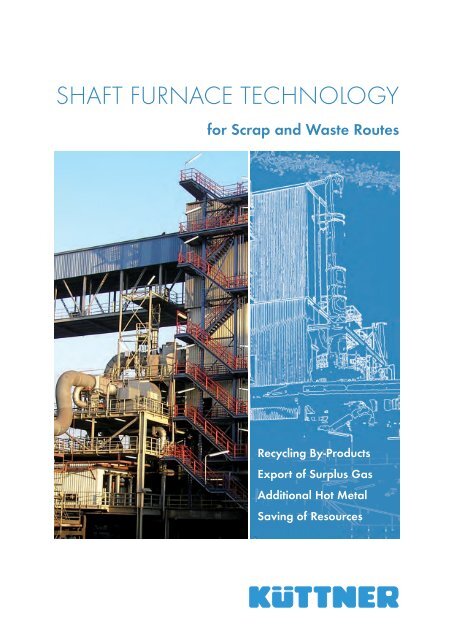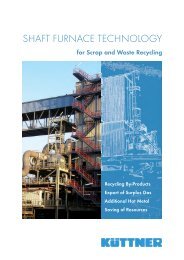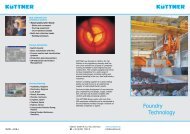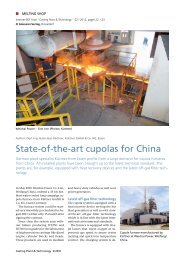SHAFT FURNACE TECHNOLOGY
SHAFT FURNACE TECHNOLOGY
SHAFT FURNACE TECHNOLOGY
Create successful ePaper yourself
Turn your PDF publications into a flip-book with our unique Google optimized e-Paper software.
<strong>SHAFT</strong> <strong>FURNACE</strong> <strong>TECHNOLOGY</strong><br />
for Scrap and Waste Routes<br />
Recycling By-Products<br />
Export of Surplus Gas<br />
Additional Hot Metal<br />
Saving of Resources
Sicartsa,<br />
Mexico<br />
Horno Oxicupola<br />
500.000 tpy<br />
from scrap<br />
Nippon Steel,<br />
Japan<br />
Shuttle furnace<br />
450.000 tpy<br />
from scrap<br />
JFE, Japan<br />
Twin shaft plantunder<br />
construction<br />
ThyssenKrupp<br />
Steel,<br />
Germany<br />
OXYCUP ® for<br />
in-plant by-products<br />
recycling<br />
TISCO, China<br />
Ferric dust and<br />
skull recycling<br />
OXYCUP ® plant<br />
CUSTOMISED <strong>SHAFT</strong><br />
<strong>FURNACE</strong> PLANTS<br />
During the past few years<br />
Küttner has supplied to the<br />
steel industry a number of<br />
large shaft furnace melt shops<br />
for scrap operation.<br />
The scrap route was implemented in works looking<br />
for additional hot metal supply for their existing<br />
steel making capacities or a way to<br />
decrease specific CO 2 emission by supplementing<br />
ore-based BF production.<br />
Shaft furnaces are well suited for a variety of different<br />
metallic charge materials like:<br />
• dirty heavy metal scrap HMS1/2<br />
• galvanised scrap (baled/shreddered)<br />
• pit scrap or iron/steel skulls<br />
Successful tests have been realized with HBI.<br />
Based on this it is now possible to also project<br />
plants for pre-reduced/direct reduced materials<br />
from rotary hearth/kiln or natural gas based<br />
reduction plants. The integration of the melt<br />
shops into the works operation was implemented<br />
in close cooperation with the plant departments<br />
specialized in iron and steelmaking, energy and<br />
environment or automation.<br />
OXYCUP ® shaft furnace technology<br />
is also ideally suited<br />
for the waste route.<br />
Recycling of in-plant by-products saves valuable<br />
resources and reduces landfill disposal. The<br />
OXYCUP ® process is a smelting reduction<br />
process based on self-reducing agglomerates,<br />
so called C-Bricks. This technology is a common<br />
development of ThyssenKrupp Steel and<br />
KÜTTNER.
FeO + C => Fe +<br />
CO<br />
C-Bricks from<br />
dust, sludge,<br />
ore fines<br />
BOF pit scrap<br />
Pig iron skulls<br />
ZERO WASTE: RECYCLING<br />
SAVES VALUABLE RESOURCES<br />
In contrast to other alternative iron making processes the<br />
OXYCUP ® melt shop directly produces liquid hot metal<br />
similar to blast furnace quality. A C-Brick may be composed<br />
of a variety of different ingredients. In particular<br />
matter with high iron content like BOF dust or sludge is<br />
welcome, but also matter with high carbon content like<br />
BF sludge. The agglomerates are produced on site in<br />
the C-Brick making plant.<br />
BOF dust e.g. contains 65 % of iron –<br />
only 10 % less than high grade ores.<br />
This is the basis of the Zero Waste<br />
Concept of ThyssenKrupp Steel.<br />
The direct reduction of the iron oxides is mainly done by<br />
the carbon present in the brick. Compounds like lime<br />
and silica contained in the residues determine the basicity<br />
of the slag together with about 10 % cement being<br />
added as a binder.<br />
Recycling of zinc and alkali containing fines as well as<br />
of lumpy residues of unknown analysis is now possible<br />
for the benefit of the classic sintering process as well as<br />
for blast furnace route and converter operations.<br />
Easy integration into a steel mill, high process flexibility<br />
with respect to charge materials and operation, low<br />
space and investment requirements are additional<br />
advantages of this economic waste and by-product processing<br />
technology.<br />
The environment benefits as well: All emissions with<br />
respect to SOx, NOx, Dioxines, etc. are far below the<br />
legal limits.<br />
After more than two years of successful commercial operation<br />
the OXYCUP ® process has turned out to be a reliable<br />
proven technology. A variety of different residues<br />
has been used in C-Bricks mixtures and converted to hot<br />
metal. The percentage of bricks in the charge can be<br />
varied between 0 % and 100 %, the balance being<br />
lumpy residues like pit scrap/skulls or zinc coated bales.
OXYCUP ® :<br />
HOW IT WORKS<br />
Smelting reduction with<br />
self-reducing C-Bricks<br />
Charged from the top into the OXYCUP ® shaft furnace the<br />
self-reducing C-Bricks are first pre-heated in counterflow<br />
with the furnace gas to some 500 °C. First metallic iron<br />
will form in an outer shell of the brick. This shell will grow<br />
and secure the stability of the brick above 1,000 °C<br />
where the cement will disintegrate and direct reduction<br />
starts with the help of carbon included.<br />
At about 1,450 °C the brick has totally converted into<br />
solid iron sponge which is melted together with other<br />
metallic charge in the hearth. The hot metal will leave the<br />
hearth continuously over an iron-slag siphon system at<br />
1,500 °C with a carbon content of about 4 %.<br />
ThyssenKrupp<br />
Steel, Germany<br />
C-Brick making<br />
plant with mixing<br />
tower and curing<br />
hall
Sicartsa,<br />
Mexico<br />
Horno Oxicupola<br />
500.000 tpy<br />
from scrap<br />
Nippon Steel,<br />
Japan<br />
Shuttle furnace<br />
450.000 tpy<br />
from scrap<br />
JFE, Japan<br />
Twin shaft plantunder<br />
construction<br />
ThyssenKrupp<br />
Steel,<br />
Germany<br />
OXYCUP ® for<br />
in-plant by-products<br />
recycling<br />
TISCO, China<br />
Ferric dust and<br />
skull recycling<br />
OXYCUP ® plant<br />
CUSTOMISED <strong>SHAFT</strong><br />
<strong>FURNACE</strong> PLANTS<br />
During the past few years<br />
Küttner has supplied to the<br />
steel industry a number of<br />
large shaft furnace melt shops<br />
for scrap operation.<br />
The scrap route was implemented in works looking<br />
for additional hot metal supply for their existing<br />
steel making capacities or a way to<br />
decrease specific CO 2 emission by supplementing<br />
ore-based BF production.<br />
Shaft furnaces are well suited for a variety of different<br />
metallic charge materials like:<br />
• dirty heavy metal scrap HMS1/2<br />
• galvanised scrap (baled/shreddered)<br />
• pit scrap or iron/steel skulls<br />
Successful tests have been realized with HBI.<br />
Based on this it is now possible to also project<br />
plants for pre-reduced/direct reduced materials<br />
from rotary hearth/kiln or natural gas based<br />
reduction plants. The integration of the melt<br />
shops into the works operation was implemented<br />
in close cooperation with the plant departments<br />
specialized in iron and steelmaking, energy and<br />
environment or automation.<br />
OXYCUP ® shaft furnace technology<br />
is also ideally suited<br />
for the waste route.<br />
Recycling of in-plant by-products saves valuable<br />
resources and reduces landfill disposal. The<br />
OXYCUP ® process is a smelting reduction<br />
process based on self-reducing agglomerates,<br />
so called C-Bricks. This technology is a common<br />
development of ThyssenKrupp Steel and<br />
KÜTTNER.
THE WINNER:<br />
THE ENVIRONMENT<br />
Direct hot metal from in-plant<br />
by-products<br />
In integrated steel works an OXYCUP ® furnace<br />
supplements the hot metal from the blast furnace.<br />
Because of the comparatively small quantities, torpedo<br />
cars or iron ladles first collect a portion of<br />
hot metal from the OXYCUP ® and then mix it by filling<br />
up with hot metal from a blast furnace. After<br />
de-sulphurization the hot metal mixture is transferred<br />
to the steel shop.<br />
In times of high hot metal demand the OXYCUP ®<br />
can almost double its production if a high iron<br />
charge, like 100 % pit scrap, is employed. Only<br />
170 - 200 kg of coke are necessary to convert pit<br />
scrap into one ton of hot metal. Low CO 2 emissions<br />
are the result.<br />
Environmental authorities from the USA, Mexico,<br />
Japan and Germany have confirmed that all other<br />
emissions are also far below the permissible limits.<br />
The cleaned top gas of blast furnace quality is<br />
used in the gas network of the steel plant. In combination<br />
with electric melting the OXYCUP ® can<br />
solve the residue problems of high zinc containing<br />
dusts. Charging the liquid hot metal into an electric<br />
arc furnace reduces electric power consumption.<br />
The winner is always the environment.<br />
curing hall<br />
for C-Bricks<br />
cooling<br />
towers<br />
brick press<br />
coke, additives<br />
C-Bricks storage<br />
mixing tower<br />
4 silos for cement & dusts<br />
brick conveyor<br />
coke & additives conveyor<br />
hot blast generation<br />
settling basin<br />
scrubber<br />
conveyor belt<br />
skulls and scrap area<br />
C-Brick bins<br />
OXYCUP ®<br />
hot metal discharge<br />
coke and additive<br />
charging bins<br />
OXYCUP ®<br />
in an integrated<br />
steel mill<br />
OXYCUP ®<br />
discharging of<br />
hot metal in a<br />
torpedo car<br />
truck discharge<br />
for sludge<br />
materials<br />
130 m<br />
OXYCUP ® plant<br />
exemplary layout<br />
for 350,000 t/yr<br />
input
KÜTTNER GMBH & CO. KG<br />
The engineering company, which was founded<br />
in 1949 by Dr. Carl Küttner, has evolved into a<br />
group of companies working worldwide in<br />
plant engineering and construction. The company<br />
supplies and erects turnkey installations for<br />
a wide range of process technologies, including<br />
melting and material handling in the iron,<br />
steel and foundry industries.<br />
KÜTTNER has build different types of furnaces,<br />
like fluidised bed, rotary and shaft furnaces for<br />
organic/anorganic waste, non-ferrous metals<br />
and iron processing. The furnaces presented<br />
in this field are a development of the long<br />
campaign cupola furnaces for steel mills.<br />
The services provided include development of<br />
new technologies, engineering and design,<br />
supply, installation and start-up of plants<br />
complete with controls and data processing<br />
systems.<br />
The KÜTTNER Group today has a worldwide<br />
workforce of more than 500. It is represented<br />
in the international markets through a network<br />
of affiliated companies and agents.<br />
Its owners hold active positions within the<br />
company organisation.<br />
Küttner GmbH & Co. KG<br />
Alfredstr. 28 · 45130 Essen<br />
Phone +49 (0) 201 72 93-0<br />
Fax +49 (0) 201 77 66 88<br />
tl-st-1@kuettner.com<br />
www.kuettner.com<br />
6317 e






